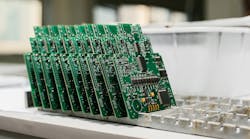With the broadest range of products and longest list of customers in the semiconductor industry, Texas Instruments acts as a thermometer for the overall health of the sector. So when the company reported dwindling demand in its industrial, consumer and automotive markets in October, Wall Street sounded an alarm bell. The only question was how severe the slowdown would be.
On Wednesday, the largest vendor of analog chips returned with a response: things could be worse. Texas Instruments forecast first quarter revenue in the range of $3.34 billion to $3.62 billion, slightly off analyst estimates of $3.43 billion to $3.68 billion. Profits in the current quarter are projected to be around $1.11 per share.
For comparison, Texas Instruments reported $3.79 billion of revenue in the first quarter last year, while profits were $1.35 per share.
"After 10 quarters of year-on-year growth, the weakness we are seeing is primarily due to the semiconductor cycle," the company's chief financial officer, Rafael Lizardi, said in an analyst conference call Wednesday. "That is just the sort of thing that happens in the semiconductor industry," he added.
Lizardi said that "the macro-environment, including uncertainty caused by trade tensions, could impact the depth and duration of this cycle."
Texas Instruments also reported fourth quarter results, which showed slowing growth in revenue. Chip sales targeting smartphones and other personal electronics—which accounted for 23 percent of the its revenue last year—declined in demand, particularly in China. The company blamed trade tensions with the United States for dampening demand in China, which was weaker than other regions.
The company's chips are among the basic building blocks of electronic devices, and it has been taking advantage of the increasing amount of analog electronics used in cars and industrial control systems. Chips targeting these applications accounted for 56 percent of the company's sales last year. But sales started slipping in the third quarter last year and continued into the fourth quarter.
The slowdown was softened by strong sales of chips used in communications equipment, which rose 20 percent last quarter because of early 5G deployments. That helped Texas Instruments grow its core analog business around 4 percent year-over-year. The company's embedded processing business fell around 12 percent over the last year as demand for microcontrollers declined.
Texas Instruments reported revenue of $3.72 billion in the fourth quarter. Profits rose to $1.24 billion. Earnings were $1.27 per share. "Revenue decreased one percent from the same quarter a year ago as demand for our products continued to slow across most markets," chief executive officer Richard Templeton said in a statement. Templeton took over as C.E.O. for the second time last year.
Texas Instruments is stashing unsold inventory longer and longer, which generally means that it is manufacturing chips faster than it can sell them. The company's inventory days increased from 134 to 152 days over the last year. Texas Instruments was holding onto $2.22 billion of inventory at the end of the fourth quarter last year, up from $1.96 billion in the fourth quarter of 2017.
It can afford to hold onto inventory longer than other players in the chip industry. The company's chips typically have long life spans, often remaining in use for more than a decade before becoming obsolete. They can be sold years after being manufactured. Still, Texas Instruments has been reigning in production to avoid building up its inventory, which is above normal levels, Lizardi said.
"If we can run sideways for a while, we are prepared to support a potential snap back," he said on Wednesday's conference call. "Or if it is deeper and longer, then we have to make further adjustments." He added: "During this period of weaker demand, we will stay focused on what will make us stronger long term and diligent in the short term."

